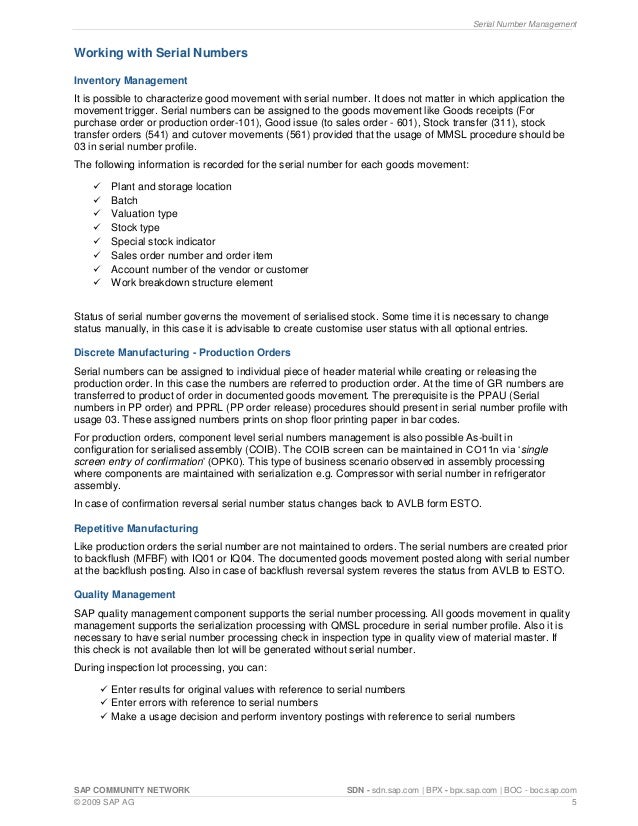Sap Serial Number Status Esto
I’ve come to realize that I haven’t talked much about a very important aspect of service management, that’s serial numbers. If you haven’t checked out my SDN post on the, I recommend it. It will help you understand this coming post even better. Today I wanted to continue talking about the serial numbers, but today I want to focus on the system status’ you will encounter and what they mean to you. Like everything in SAP, there are a lot of possible status’ out there, but I’m going to concentrate on the common ones you will see, and the some of the headaches you may encounter because of them. Scientist Dub In The Roots Tradition Rar Files.
Here’s the most common equipment status you’ll encounter: • AVLB: This is the easiest one to deal with, but the least informative. This status is pretty much the same as saying I exist, but I don’t know where. If you have the status AVLB, then you use it in scenarios from or to the customer. Typically this status is assigned if you manually (or in mass) create the equipment record and it hasn’t been assigned to anything yet. • ECUS: This means that the equipment is at the customer. Class Vp Software here.

If this status has been assigned, then you won’t be able to use it for outbound deliveries, or material movements (at least if you have stock checking turned on). The only thing you can do with this status is an inbound delivery or Lock it. You may also see this status combined with EDEL (which means that it is customer owned and on a delivery). • ESTO: This means that the equipment is in stock at your facility. It could be any plant or location, but it is now in stock, and you can no longer perform an inbound delivery, but you can do material movements on the serial number and you can do an outbound delivery. • EDEL: This means that it is on a delivery.

If you have an open delivery that has not been PGI’d or PGR’d, then you will see this status with either ECUS or ESTO (which will tell you if it’s an inbound or outbound delivery). This can be a particularly nasty status. I’ve seen many instances where deletion of a delivery does not always reset this status. (Next post I’ll talk about how to fix things that get messed up). • ELOK: This is the same as marking the equipment for deletion. Once you set this status you can’t do anything with the serial number.
If you need it, you can unlock it again, but as long as this status exist, the serial might as well NOT exist =) I hope this helps explain the status’ a little better on the equipment. Next time I’ll explain how you fix the status when SAP gets “Confused”. As always, thanks for reading and don't forget to check out our at my other company JaveLLin Solutions, Mike. Sorry for the delay. I’m far from an expert in movement types, but let me see if this might help at all. When I look at the configuration (txn: OMJJ) here is what I see for 101 for PO’s Lang Mvmnt spc stk Mvt Ind Recp Consum Desc EN101 B GR goods receipt EN101 B AGR for asset EN101 B EGR for sales order EN101 B PGR for sales ord.st. EN101 B VGR for acct.
Sap serial number status ecus. Change the serial number status from ECUS EDEL ESTO To. Serialization is a way to keep track of individual items (material masters). When processing transactions, example Goods Receipt, Physical Inventory, etc. You don't just type in material and quantity but also the serial numbers of the individual items. Serial numbers is a unique number that identify an item. Example if quantity.
EN101 BX GR stock in transit EN101 BXAGR st.in trans:asset EN101 BXVGR st.in tr:ac.assg. The only different I see is in the consumption category.
The GR for receipt is blank, while for the account assignment it is V (consumption). It seems this value is driven from the account assignment category on the PO. (sorry if you already know all this, this is outside of my expertise).
My best guess is that because it’s listed as consumption, the system assumes it will be consumed by an internal assembly, thus it is AVLB, rather in ESTO. Sorry I don’t know beyond that. Hi Anil, is this a one time issue? Or is this a common process for you?
If it’s a one time, you can go into the equipment and use the manual transaction and switch the status to be TO Customer, or something like that. If this is a common process, this will become more cumbersome. I have run into this scenario when dealing with intercompany scenarios. Unfortunately, the equipment status is a hard stop, and must be reset before doing certain transactions (installation/dismantle from a FLOC, stock movements, etc.) Share any additional details, and I’ll do my best to help. Thanks, Mike.